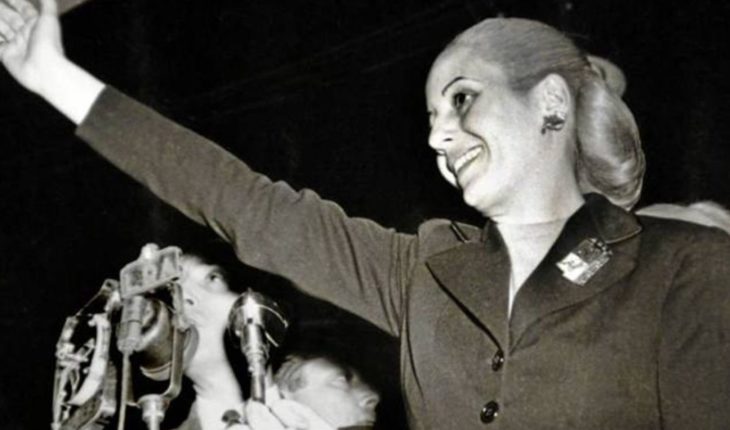The figure of Eva Duarte de Perón transcended from politics. That was their area of action and from where ‘ happened to immortality ‘ on July 26, 1952. In spite of that, the Argentinian writers were nourished of its figure and its history in various tales, texts and novels. From Jorge Luis Borges to Rodolfo Walsh, two notable writers but in opposing ideological poles, the figure of Evita was used in the national literature. Here, a review of some of them dead lady–David Viñas
In the story included in the book The Bad Manners the Argentinean writer, exiled during the liberating revolution and the last civil-military dictatorship, uses the funeral of Eva Perón as the scene of a story that ends badly when Moure, the protagonist, Insult the deceased. In the story published in 1963 you can see a clear nod to another story dedicated to the ex-wife of Juan Domingo Perón, that woman, Rodolfo Walsh, even though Walsh published it two years later. Over several paragraphs beginning with the first, the narrator refers to the protagonist as ‘ that woman ‘, who rejects Moure when it defines as ‘ mare ‘ to Eve: “Ah, No… Yes No (…) I don’t allow that. ” Throughout the story, the protagonist criticizes and mocks those who make long lines, like those described by vineyards. They do their needs on the street and push to advance, which irritates Moure. That woman-Rodolfo Walsh
The writer told me that writing this story took him 2 days and 10 years. He wrote a large part one day, grabbed him 10 later and finished it another day. Throughout history it relates the conversation between a journalist and a colonel who participated in the abduction of the body of a woman who is never named, but it is mentioned that she is embalmed and ‘ it shows the metastasis of cancer ‘. “If I find her, fresh high waves of cholera, fear and frustrated love will rise, powerful vengeful waves, and for a moment no longer feel alone, I will not feel like a dragged, bitter, forgotten shadow,” says the narrator-is in the first person-on the body. The Colonel is concerned about the threats and criticism he receives from the people, who believe he was the one who participated in the theft of the body. “They think I’m to blame. Those rusty don’t know what I did for them. But one day he’s going to write the story. Maybe you’ll write it, “he says in one of the many dialogues. Before the journalist, the Colonel tries to always show himself as who saved the body of that woman of worse vexations: to be thrown in the river, that ‘ the Galician ‘ practises the necrophilia. The colonel wants the daughter to ‘ catch polio ‘, on the poliomyelitis, which in the first half of the TWENTIETH century stalked the country. And closes, “It is mine,” he says simply. That woman is mine. ” The drill-Jorge Luis Borges
In a short story, Borges, fervent anti-Peronist, recreates a false wake to an alleged Eva Perón, but made with “a board on two trestles and a cardboard box with a blonde hair doll (…) They lit four candles on tall candlesticks and put flowers around. ” The ‘ farce ‘ is made to such an extent that women, boys and men who came to the place gave condolences to those who made Perón and “lengthened the right to shake the hand that they tended.” And the teacher wonders about who carried out the drill, is “a fanatic, a sad, a hallucinated or an impostor and a cynic?” The only privileged-Rodrigo Fresán
The writer presents in this text an extremely millionaire boy, who knows nothing beyond the bars of his house, who has no access to newspapers or “national chores.” This child starts sexually at the age of eleven no more or anything less than the corpse of Eva Perón, but did not know by its national isolation. “Journals and future diaries would make me know of the flag-bearer of the poor, of their eternal and secret transit of religious relic by different European ossuaries and of the greatness of my blasphemy.” Says the boy. When this boy kissed and had carnal access to the body of the woman he was discovered and “four men in uniform who placed the body inside a drawer and took it forever.” Evita Vive-Néstor Perlongher
Perlongher back to Evita in the decade of the 70 ‘ as a sort of Argentine Jesus that comes before his shirts to save them from police repression, participate in a trio or be a prostitute. ” Grasitas, Grasitas mine, Evita watch everything, Evita will go back to this neighborhood and all the neighborhoods to do nothing to their shirts, “says the Evita de Perlongher in the second story. Colloquial and even sometimes bizarre, the writer introduces ‘ the spiritual head of the nation ‘ back to life and the mundane aspects of life. Avoids drugs, fights with the police, wallows on the floor, has sex. Evita lives but actually avoids coming back. These are just some texts of the Argentinean literature where Eva Perón appears. You can also leersela in Santa Evita and Perón’s novel, Both of Tomás Eloy Martínez; Roberto and Eva: History of an Argentine love of William Saccomanno. In the theatre: Eva Perón de Copi; Eva Perón at the bonfire and paws in the sources of Leonidas Lamborghini; Eva and Victoria, by Monica Ottino. In this note:





